Bees are the best pollinators on the planet. Without bees, roughly 70 percent of the crops grown around the world would not flourish. But, there are both good and bad bees when it comes to cohabitating with them and depending upon them for pollinating.
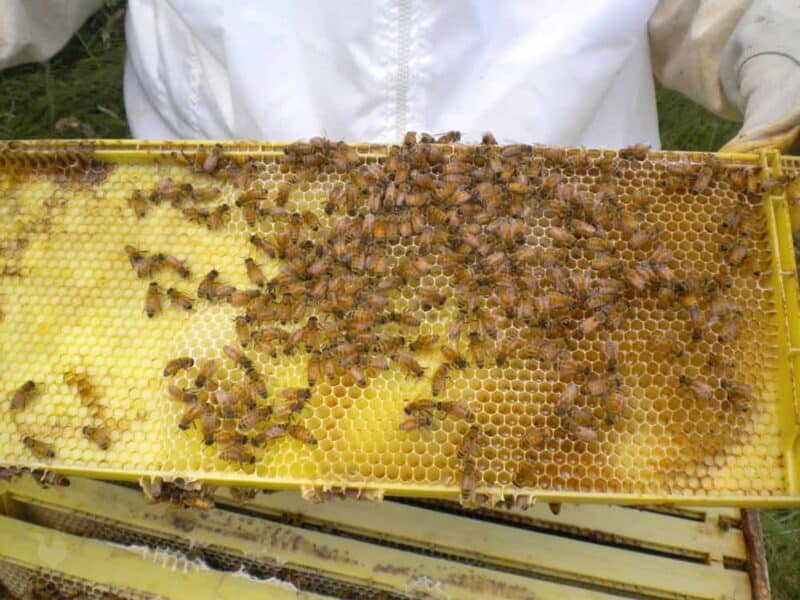
In fact, there are even some bee varieties that pollinate well that you still probably do not want to live around. Protecting the bees and courting beneficial ones to your homestead garden is one of the best things you can do to help ensure a bountiful harvest.
Bees of all types depend upon flowers and plants to fulfill at least a part of their daily nutritional needs. They collect nectar from plants as their primary source of energy.
Nectar is filled with the sugar compounds that some types of bees require to make honey inside their hive. The pollen they also collect boasts high percentages of both protein and fat.
As bees collect pollen they carry it along with them from flower to flower – some species are more adept at this process than others. This process is referred to as cross-pollination, and it is essential to the growing process so flowers and plants produce more seeds.
A few of the “bees” on this list are not exactly bees – but are flying insects that are commonly mistaken for or referred to as bees… and pollinate plants, too.
How to Tell the Difference Between Good and Bad Bees
Determining what exactly constitutes a good bee or a bad bee to either attract or repel from your homestead depends on several factors.
It would be far too simple to maintain that all bees that live on your homestead and pollinate crops are good bees. Some of these same bee varieties are also aggressive and sometimes even destructive to your property.
It would be equally simplified to maintain that all bees that sting are bad or should be repelled from your land. Honey Bees, the ultimate pollinators, do sting, as well.
If you or one of your loved ones is allergic to bee stings, attracting a variety to your land that pollinates (although not as well as a honeybee) but is not prone to stinging, may very well seem like the best bee species on the planet.
The pros and cons of each bee variety on the list below should help you determine which bees you want to attract to your garden and property, and which ones you should be keen to naturally repel so they do not sting folks or destroy property.
Because most bee varieties are attracted and repelled by the same smells and plants – and are killed by the same chemical sprays, direct targeting of a bad bee home is vital to preventing the unwanted fleeing or deaths of good bees.
What Are Some Different Species of “Good Bees”?
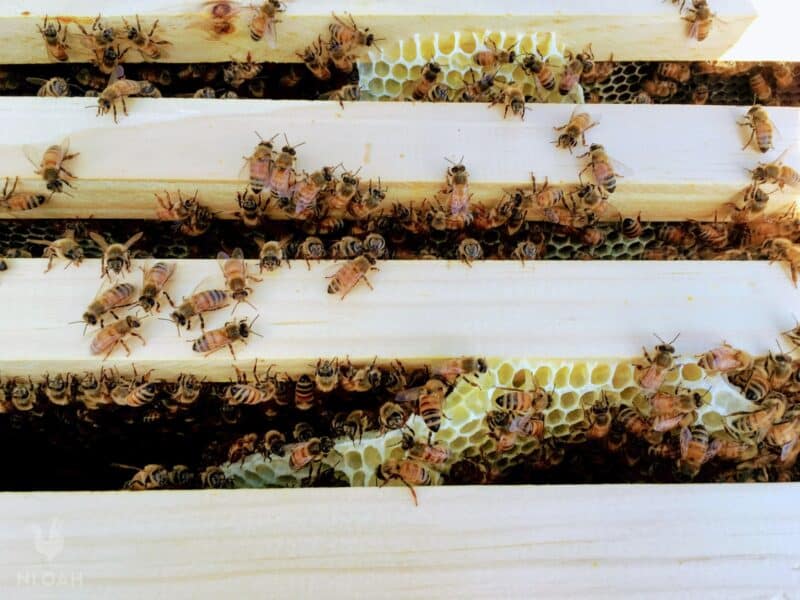
✅ Honeybees
The Western Honey Bee was imported to the United States and North America in a deliberate effort to boost the pollination of agricultural crops. Bees of this variety are quite easy to distinguish thanks to their golden brown and black stripes on their abdomens.
In America, the vast majority of honey bees live in hives made of wood that were made either in the garage of a hobbyist keeper or purchased from a professional supplier.
Due to the decline in honey bee populations since 2005, it is becoming rarer and rarer to find a wild hive in the woods. A honey bee is fully capable of flying at least three miles to find a hive when in need of a home.
A honey bee will sting you, but she only has the capability to sting once. The stinger on a honey bee is a barbed-type protrusion that is attached to both the bee’s digestive tract and abdomen. During the stinging process, the barb gets stuck inside of its intended target and literally rips out her own guts.
In my opinion, a honey bee is not only a good bee, but the best variety on the planet. They are not aggressive by nature, even though they will sting when feeling threatened. It is far more unusual to get stung by a honey bee than not to get stung by a honey bee.
Honey bees are not only excellent pollinators but also superb honey and wax producers. Keeping a colony of honey bees (I recommend the calm and docile Italian breed) could keep your family in honey year round, supply wax for candle and salve making, keep your crops growing – and perhaps even provide a profitable homesteading side hustle, too.
Honeybee Facts
Pollination – Honey bees pollinate a massive array of plants, agricultural crops, herbs, as well as fruit and nut trees. Because honey bees are a clean lot, they are not as efficient as some other types of bees (such as mason bees) when it comes to pollination.
They clean the pollen off of their hairy legs before flying onto the next flower, taking a smaller percentage of it with them. But, the honey bee life cycle is highly conducive to the spring and summer growing seasons.
Stinging – Both male and female honey bees possess the capacity to sting, but are not typically aggressive – unless they feel you are getting threateningly close to their colony.
While it is not recommended, some beekeepers feel they have developed a level of trust with their colonies and do not gear up in their suits when working with the hive.
Habitat – Honey bees live in a colony in either a man-made or natural hive typically built onto a tree branch.
Removal – If you encounter a wild honey bee hive on your homestead it is best to call a professional to remove it, because the inhabitants will become very agitated when you approach the colony and risk battling a swarm – quite possibly even at night.
Good Bee or Bad Bee? –Honeybees are extremely good bees. They provide honey, consistent pollination for plants, herbs, and crops, as well as wax.
Unless you have a wild hive on your land that is in a problematic place, or have a loved one that is allergic to bee stings and could encounter them, it is most likely far more beneficial just to allow the bees to be your helpers in the garden than to have them removed.

✅ Bumblebees
There are nearly 50 different varieties of bumble bees native to the United States. Bumble bees are slightly larger than honeybees, and have black bodies that are densely covered in both black and yellow hair.
Bumblebees are often confused with carpenter (also known as boring) bees. The destructive carpenter bee (definitely a bad bee in my opinion) may look similar to a bumble bee, but is significantly larger in size. Bumble bees also have smaller and less broad heads than carpenter bees.
Bumblebees got their name from the loud noise they make when collecting pollen inside of a flower. Because they move about so rapidly collecting it, these bees appear to be dancing and create an ultrasonic vibration …. buzzing.
Bumblebee Facts
Pollination – Bumble bees are especially adept at pollinating tomatoes. Like honey bees, bumble bees groom the pollen they collect and carry it back to a hive using the “pollen baskets” in their legs.
Bumble bees do make honey but not in surplus amounts beyond the needs of their own colony, so they are not kept residentially or personally for this purpose.
Stinging – Bumblebees do sting, and the impact is slightly larger and more painful than a bee sting. But, unless you accidentally step on a bumble bee nest or clasp a bumble bee, it would be rare that you would get stung – unless you intentionally or accidentally get too close to their hive.
Habitat – Bumble bees live in colonies like bumble bees, but they build their nest in the ground or abandoned holes. Their colonies are far smaller than those of honey bees, and typically contain only a few dozen members instead of hundreds.
Removal – Bumble bee populations are on the decline just like honey bees.
It would be best to let the sometimes dubbed “bad bees” alone to pollinate our tomatoes, but if they are causing a concern over stinging of someone with an allergy to stings or for some other serious problem, spray their nest with a 2 parts vinegar to 1 part water solution after dusk then the colony members are all back inside for the night.
Good bee or bad bee? Bumblebees are not as good as pollinating as honey bees and do not create honey or wax for you, but their adeptness as pollinating many types of plants – tomatoes in particular, make them worthwhile to have around.
They are much larger, compared to the size of other bee species, so you shouldn’t have a hard time telling them apart.
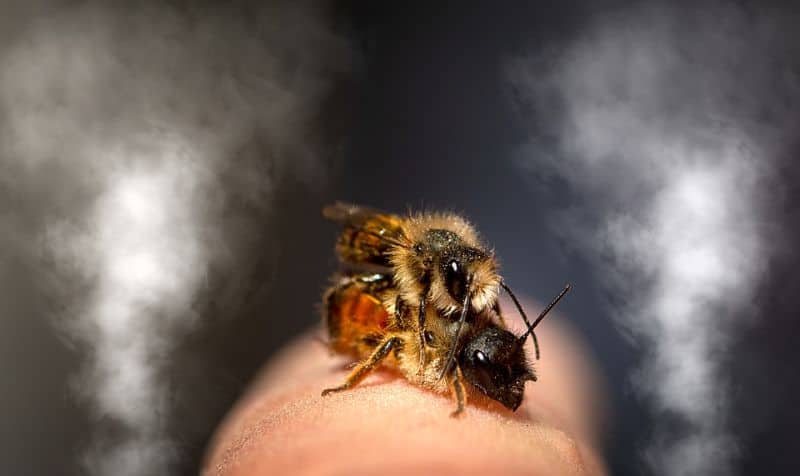
✅ Mason Bees
These tiny bees are amazingly quick and agile fliers. Mason bees (not to be confused with carpenter/boring bees) are beautiful, as well. These bees are metallic blue, black, and green in shade.
The pollen collected by Mason bees is carried in the hairs on the underside of their abdomens, and not in pollen baskets like either honey bees or bumble bees. Because mason bees do not clean themselves before hopping from plant to plant, they actually gather and tote more pollen than honey bees.
Before you rush out to the garage and make a simple mason bee “hotel”(or get one online), there are some drawbacks to keeping mason bees from a gardening perspective.
The life cycle of a mason bee is so brief that they are only around to do some great early spring pollinating of fruit blossoms and early crops.
Mason Bee Facts
Pollination – Mason bees in orchards can give a substantial boost to fruit trees and a huge boost just as they are flowering and go into bud. But, without the aid of honey bees throughout the growing season, the harvest will fall far short of expectations.
Stinging – Male mason bees do not possess a stinger. Female mason bees do have a stinger, but rarely ever use it because they do not have a colony to protect like either honeybees or bumblebees.
Habitat – Mason bees are a solitary bee variety. They fill hollowed-out twigs, stems, or man-made “hotels” with their eggs, building a wall of mud of other debris in-between each egg laid – hence their name.
Once a female mason bee has laid an egg (they usually lay 10 total) she will gather nectar and other food enzymes to leave inside the “hotel room” with each egg so the larvae have nourishment when it hatches. The eggs leave their lodging fully developed the following spring.
Removal – Because only the eggs are left for any length of time in a mason bee habitat, you can simply spray the “hive” with water if it cannot be removed and stomped.
Good bee or bad bee? – Mason bees do not cause harm to any structures and truly rarely sting and are all-star pollinators. Mason bees are very good bees to have on your homestead.
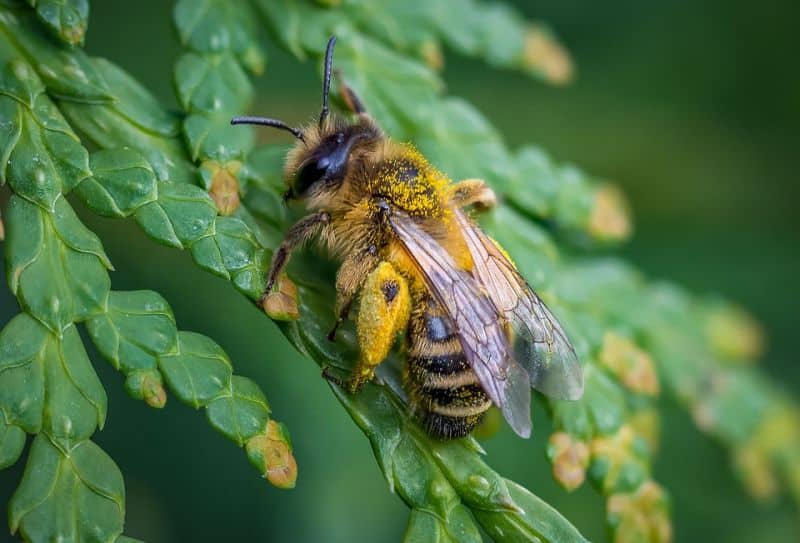
✅ Leafcutter Bees
Members of this bee variety share some similarities with mason bees when it comes to nesting. Instead of mud to seal up their nesting cavities, leaf cutter female bees use leaves to ensure their eggs are sealed up in a safe space.
Leafcutter bees have black bodies with white hairs that cover the underside of their abdomen and thorax. These bees have broad heads and strong jaws designed to help them cut leaves off from trees to seal up their nests.
They are fast fliers and carry pollen on their abdomens like mason bees instead of in pollen pockets. Female leafcutter bees will find a male drone to mate with, and then seek out a place to make a little nest, and raise their brood of bees all on her own.
Leaf Cutter Bee Facts
Pollination – Leafcutter bees are drawn to wild flowers for pollination more than any other type of plant, so they may not be extremely beneficial to your garden, but could increase foraging opportunities around the homestead substantially.
These bees will also pollinate some vegetable and fruit plants, but not as a first choice – with a few exceptions. Commercial blueberry, onion, alfalfa, and carrots growers often keep leaf-cutter bees to help increase their annual yields.
Stinging – While leaf cutter female bees do sting, they are solitary like a mason bee, and don’t have a nest to protect and guard.
Only if you press your skin against a bee of this variety accidentally or on purpose, will you likely get stung. I have never been stung by a leaf-cutter bee, but am told that their sting is less painful than that of either a bumble bee or a honey bee.
Removal – Because leaf-cutter bees rarely sting and do not cause destruction, folks rarely ever bother trying to remove them. These bees are attracted to dead or drying plant stems because they provide a tunnel or tube-style place to lay eggs.
Cut away dead parts of plants or cover plants with cheesecloth and place a bee hotel away from your growing area to help relocate leafcutter bees.
Good Bee or Bad Bee? – Even though leaf cutter bees can chew upon plants, they cause little real destruction and can help wild plants and specific cultivated plants get pollinated heavily and thrive… a good bee in my book.
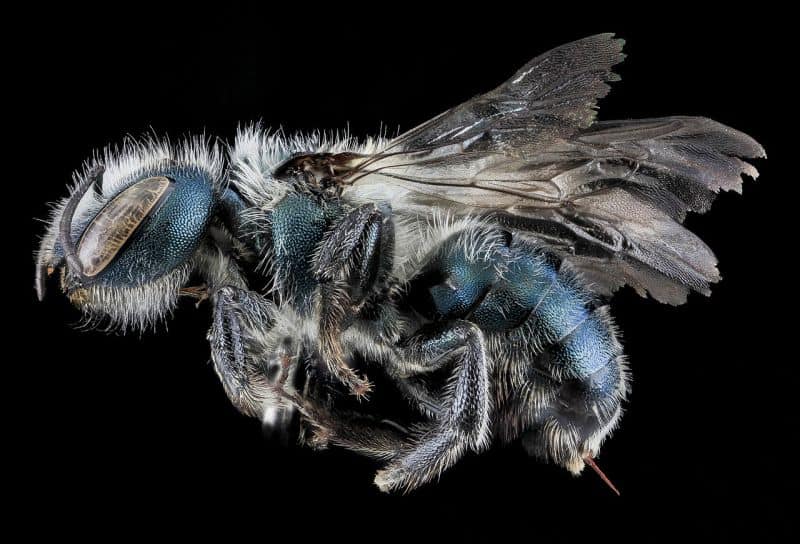
✅ Blueberry Bees
These unique bees are like a mini-me of a bumble bee. They have nearly identical hair patterns and look an awful like either these large bees or carpenter bees.
Blueberry bees got their name because of not only their love for pollinating the fruit plant, but because their bodies are an extremely perfect fit to get inside of the tiny bell-shaped flower blossoms that develop on the fruit plants.
Blueberry bees nest in the ground, most often near the base of blueberry plants. These solitary bees prefer to dig out burrows to make a home in loose or sandy soil. It is not uncommon for blueberry bees to make a nest in holes, exposed roots, or in leaf debris on the ground in a secluded area.
Blueberry Bee Facts
Pollination – Blueberry bees also pollinate other flowering plants in the early spring. They do not pollinate as efficiently as many bee varieties, nor do they pollinate all plants, but when growing blueberries and other fruit trees, they can truly aid in the creation of a robust harvest.
Stinging – It would be extremely rare to get stung by a blueberry bee unless you accidentally or intentionally pressed flesh against it.
Removal – Because these are not destructive or aggressive bees, folks rarely ever see the need to remove them. But, if you strongly feel the need to remove or relocate blueberry bees, use the same tips included in this guide to get either mason bees or ground-nesting bees off of your land.
Good Bees or Bad Bees? – These are definitely good bees. They are neither aggressive nor destructive and are a huge booster to blueberry plant growth as well as early spring pollination of some other flowering plants.
✅ Squash Bees
Like blueberry bees, squash bees are small and specialized pollinators. They pollinate nearly exclusively plants in the Cucurbita families” pumpkins, zucchini, gourds, melons, and all varieties of squash.
Squash bees are one of the only bee varieties that fly before dawn. They typically only fly from pre-dawn until the mid-morning hours. They do not take flight again until around dusk when the flowers on melons and squash open back up.
If you encounter a bee on a squash flower it is in all likelihood a male bee – that is where they nest. Bumble bees also pollinate squash flowers but are too large to mistake for a squash bee and have difficulty making their large bodies steady on the blooms.
Female squash bees nest in the ground to be close to a constant food source. They too pollinate squash flowers but take care of business quickly and then fly away.
Squash bees range in color from tan to brown to orange on their heads. The thorax of bees of this type is both black and hairy with stripes on their abdomen that are tan, black, or white.
Squash Bee Facts
Pollination – They are excellent pollinators of Cucurbita plants and are heavily cultivated by commercial producers to boost their annual harvest yield. They will also pollinate some vegetable plants, but only when their primary source of food is not plentiful enough to sustain them.
Stinging – While squash bees have the capability to sting, they rarely ever do.
Removal – It would be highly unusual to find a need to remove these beneficial pollinators. But, if you must relocate them, remove any debris they are likely to nest in from around the designated area and use the same tactics for getting rid of ground-nesting bees as outlined above.
Good or Bad Bee? – Squash bees are good bees. They are neither destructive nor aggressive and do an excellent job pollinating ground vine plants.
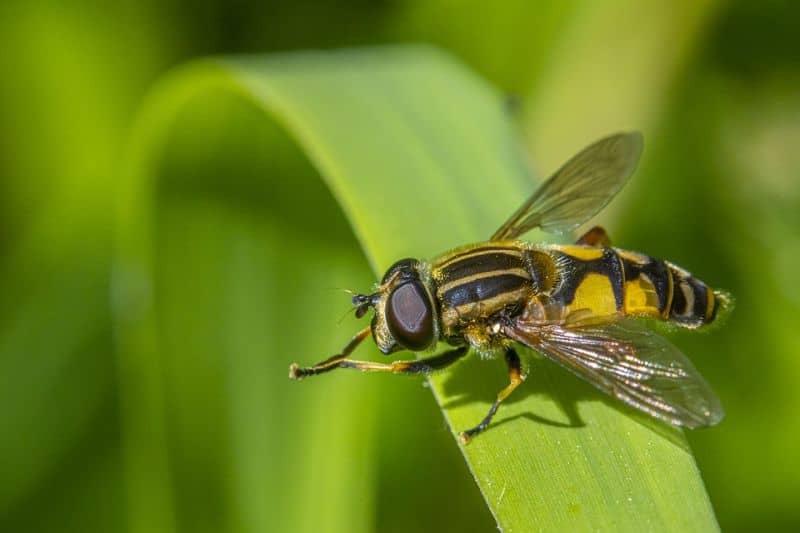
✅ Hoverflies
Hoverflies are not technically bees, but are often mistaken for them and are also pollinators – hence their inclusion on this list. Members of this insect variety are also commonly referred to as “flower flies.”
They have the largest variations of any pollinating “fly.” There are more than 6,000 different hoverfly species – most of which mimic the behavior of true bees and closely resemble them.
Hoverflies have two wings and not four wings like all bees possess. They also have different eye structures than bees – flies all have two big eyes on the side of their head.
Hoverflies are particularly attracted to flowers – hence their common nickname. Mountain mint, hyssop, and asters always attract large numbers of hoverflies.
Hoverfly Facts
Pollination – They do pollinate all manner of plants, but do not do it as efficiently as bees.
Stinging – Nope, hoverflies are not equipped with a stinger.
Removal – Hoverflies do not raise their young in either a nest or a hive. Most all species of hoverflies have “free-living” larvae that feed on aphids and other bad bugs for sustenance.
Good or bad? – Hoverflies should not be swatted, but allowed to go about their daily business pollinating flowering plants on your homestead.
What Are Some Species of Bees That Are “Bad”?
❌ Africanized Honey Bees
As the name implies, Africanized honey bees are a subspecies of honey bees that originated in Africa and have since colonized throughout Central America and parts of the United States.
These bees differ from regular honey bees in several ways, including their behavior, stinging propensity, and impacts on the environment.
Pollination – Africanized honey bees are important pollinators, like all other species of honey bee. They are especially helpful when it comes to pollinating crops native to tropical regions, such as mangoes and papayas.
This is because they prefer warm climates with plenty of nectar sources, which is why they often settle around agricultural farms.
Stinging – Africanized honey bees are far more defensive than your average bee species, so it’s best to keep your distance if you encounter them. Even small disturbances can send them into a frenzy—which means you could end up getting stung multiple times if you get too close! It’s best to contact an expert for removal if you find these bees living near your home or business.
Removal – It is quite dangerous to attempt to get rid of Africanized honey bees, especially if you’re not familiar with keeping bees or you have an allergy.
Call a professional bee removal service, who will often relocate the colony in a safe manner and can do so without exterminating it completely. The bees can still do their important pollinating work, but you’ll be safe.
Good or Bad Bees? – Africanized honeybees are important pollinators, but due to their highly aggressive nature, should really be considered bad bees.
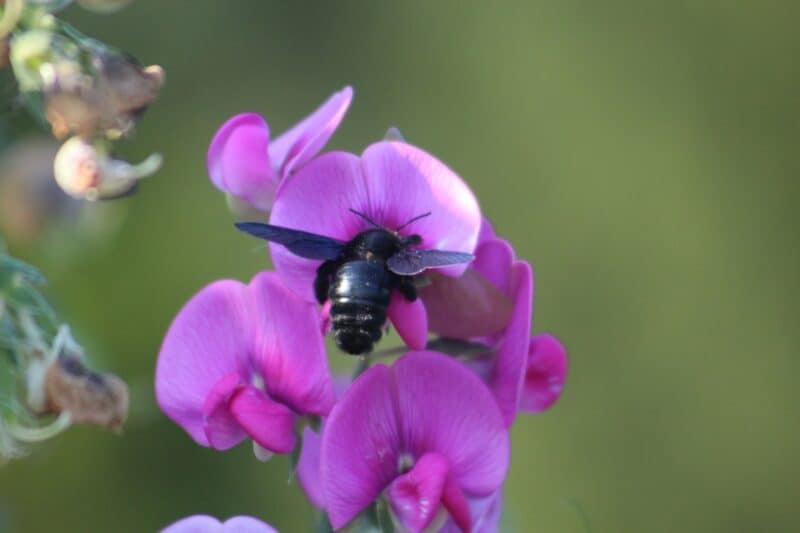
❌ Carpenter Bees
Carpenter bees are also commonly referred to as boring bees or wood bees. Female worker bees bore holes into wood with the adeptness of a power drill.
They are prone to being a nuisance on porches, decks, shelter houses – and just about anywhere else they can find a hunk of wood. Common places you might find these bees include in rafters, porch ceilings, and even in a hollow tree. They like wood!
If you discover holes on posts, beams, and in wooden lawn furniture that appear as if someone grabbed a power tool and drilled a hole in them (but no such shenanigans have taken place), you most likely have carpenter bees.
Even if you happen to miss the holes that have been drilled, the sawdust left on windowsills, stoops, and around wood posts will also alert you to the presence of these nuisance bees. Female carpenter bees make their nest to lay eggs inside the holes.
First, she will lay female eggs and then the male eggs. The following spring all of the young bees will leave the carpenter bee nest in an organized single file flight.
The single best way to prevent carpenter bees from drilling holes in the wood around your homestead is to either paint it or use a sealant covering on the bar wood.
While you can purchase carpenter bee traps, they will kill any bee that is attracted to it, including good bee varieties like honey bees and mason bees.
These bees are also prone to chewing into small flowers before they are pollinated, vastly reducing the plant or tree’s potential harvest – hence their nickname – robber barons. During this process, they steal the nectar from the blossom or flower, and don’t provide any pollination to the plant.
Yet, carpenter bees are not necessarily all bad. On large flowers the bees will do a really good job of pollination. Like bumblebees and honeybees, carpenter bees possess pollen baskets on their legs to collect their bounty.
A carpenter bee has a black body with dense black and yellow hairs on their thorax and head – but their abdomen is bald. They are territorial bees and frequently swoop down at your face to warn you away from their nests.
Carpenter Bee Facts
Pollination – The amount of pollination carpenter bees offer can outweigh the level of destruction they cause IF all of the wood on your homestead is either painted or covered in a wood sealant.
Stinging – Females have the capability to sting but rarely do – even when they are aggressively flying about your head and face. Males can be far more aggressive than females, especially during mating season, but do not sting.
Removal – Preventing the bees from taking up residence on your homestead is the best way to prevent an infestation. You can also squirt the vinegar and water mixed noted above into their nest, or by squirting citrus oil into their nest. You can also rock out near a nest, it seems carpenter bees loathe loud music and will abandon an area where it is played.
Good or Bad Bees? – While they can provide ample pollination throughout the growing season, I personally feel that carpenter bees are far more bothersome than what they are worth and always do my best to get rid of a nest any time I happen upon one.
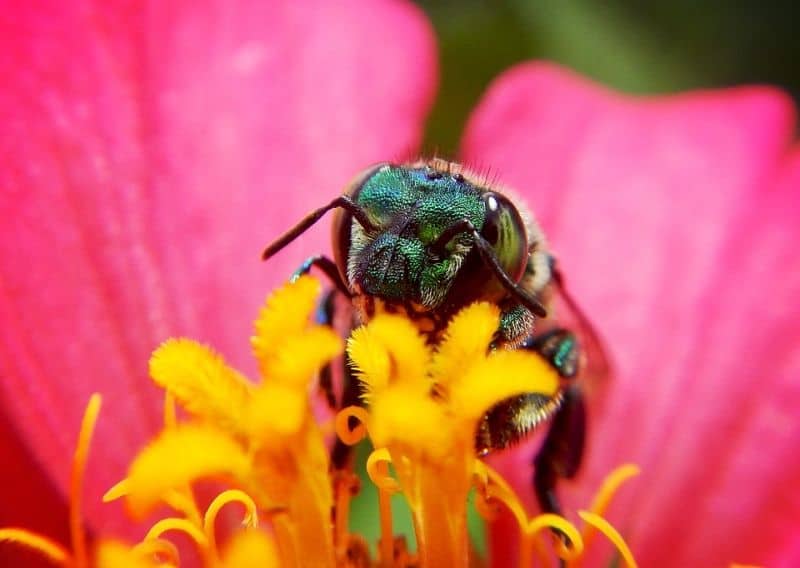
❌ Sweat Bees
These tiny bees are roughly the size of a quarter, yet can cause more than a dollar’s size of a problem for folks who encounter them. The nickname sweat bees was adeptly levied on them because they are intricately drawn to human perspiration.
What many folks do not realize is that sweat bees are not all bad. They are hardy pollinators that continue their work not just through October but even into November in some climates.
Since they are so very small, they are attracted to tiny flowers that develop on herbs and fruit-bearing plants, especially. Sweat bees are quite beautiful.
Their coloring ranges from metallic shades of blue to black, green hues, and copper. The stripes on the undersides of their bellies can also help identify this bee variety quite easily.
Sweet bees fly quickly and due to their size, you often do not see them until after they have already stung you. Their sting is less potent than that of either a honey bee or a bumble bee.
They are ground nesting bees that typically reside in a hive or nest in a burrow in a sunny area or in softwood or rotting wood.
Sweat Bee Facts
Pollination – They will pollinate any plant they happen across from the early days of spring through the fall harvest.
Stinging – Female sweat bees sting but are not aggressive. They are simply so drawn to perspiration that they land on you, and are startled by your movement to rid your files of them that they sting you.
Removal – Getting rid of rotting wood around your house, barn, or outdoor recreation areas and squirting the vinegar and water mixture into any nest that you find.
Good Bee or Bad Bee? – They are a little bit of both. They provide a fairly high level of pollination and are not destructive, so that makes sweat bees good bees.
But, anyone who spends a lot of time working outdoors on the homestead and sweating as you do it already knows how annoying it can be to get stung by sweat bees repeatedly in the process.

❌ Wasps
There are more than 100,000 species of wasps – many of which closely resemble bees. A wasp is in neither the ant nor the bee family but are part of the Apocrita suborder.
Wasps have far less hair than bees, a narrow junction between their abdomen and thorax (waist area), and come in a series of bright colors. The vast majority of wasps have yellow and black patterns on them like bees. Unlike bees though, the legs on a wasp dangle down when they are flying.
Wasps are far more aggressive than bees, and sting with greater frequency. Most but not all wasps provide absolutely no pollination help for the garden. Bees far too often get a bad rap for stinging when the insect that actually caused all the pain and swelling is actually a wasp.
There are four common types of wasps found in and around gardens that are frequently confused for bees.
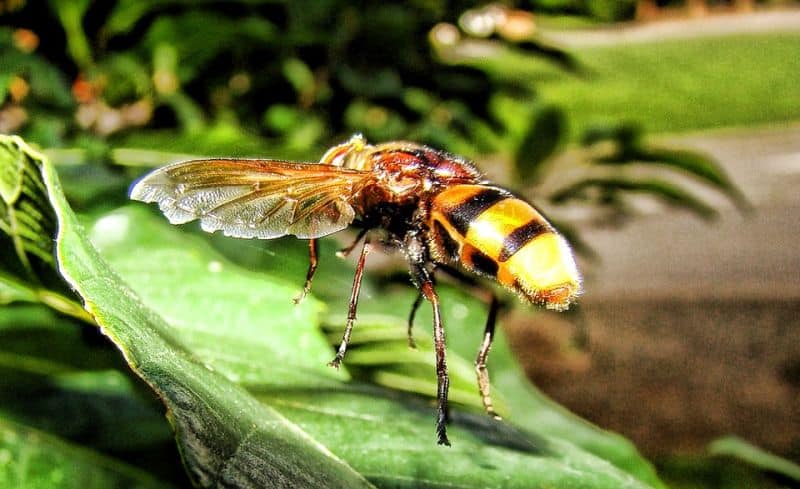
❌ Yellowjackets
Yellowjackets are a carnivorous type of wash that live in a colony, and will aggressively protect their nest. Unlike the honey bees they can be mistaken for, a yellow jacket’s stinger is lance-like, with just a small barb at the end that does not remain stuck inside of the flesh of its intended target.
It is usually the worker wasp that is most commonly confused with a honey bee. Yellow jackets are most likely the pesky flying insects that are annoying at a picnic or around a trash can at the fair and not honey bees. Yellowjackets are drawn to hot dogs and hamburgers in particular.
Yellowjackets do have the ability to pollinate but rarely use it because they prefer killing other insects for food over visiting flowers. When a yellow jacket does pollinate, it cannot carry much with it because its body lacks the fuzz or hair of bees.
If you get too close to a yellow jacket hive one to dozens of these insects can and likely will attack and sting you. Getting rid of a yellowjacket hive should only be done after dusk, when all members are inside.
Burning out the hive is how it is done here in the country, but I highly recommend calling a professional for the removal to avoid being swarmed by the colony you are trying to remove.
I would classify yellowjackets as “bad bees” because they serve little value in the garden, and their aggressive nature can cause one person to be stung violently many times. The only good thing I can say about yellow jackets is that they eat Japanese beetle larvae – they are actually the only predator of these destructive garden insects in the United States.
There are several types of yellow jackets to be aware of. One dangerous variety is the bald-faced hornet, which has black bands and white with yellow stripes.
Bald-faced hornets nest in the ground or in places like plant roots and shrubs, with nests made out of paper that can be as large as a basketball.
Though they help pollinate crops, it’s a good idea to contact a pest removal company if you find these hornets, since their stings can be painful and persistent.
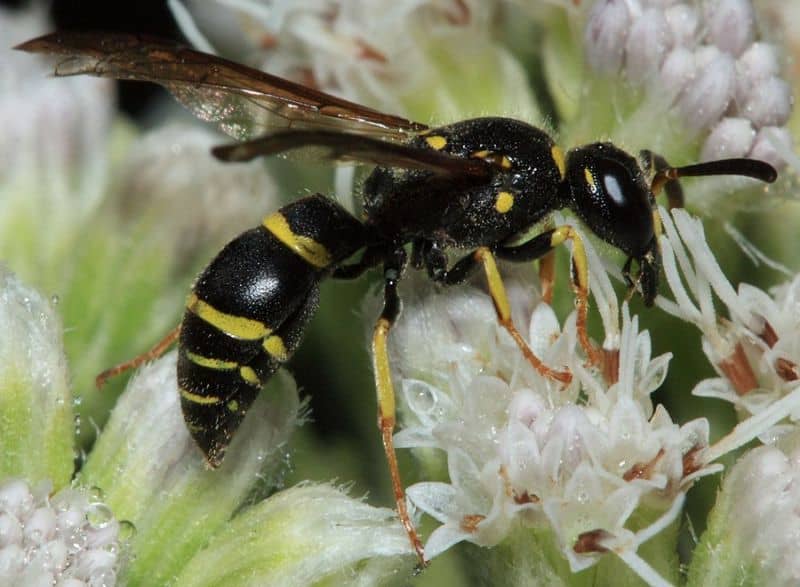
❌ Potter Wasps
In my rural neck of the woods, we refer to potter wasps as “mud daubers.” They build their small nests that resemble chubby elongated pots, in barns, sheds, on branches, vines, or durable twigs – or onto bricks and even the window screens of your home.
Mud daubers do pollinate plants but also like to dine down on caterpillars – which are destructive to your garden. They sting caterpillars to paralyze them and then feed their victims to their offspring.
Unlike the paper wasps they resemble, mud daubers are not aggressive. There are more than 200 different potter wasps, and over 3,000 different varieties of this type of wasp.
Potter wasps are fairly pretty with their yellow white, orange, brown, or black body patterns.
While potter wasps are not aggressive like yellowjackets, they will sting when feeling a threat to their nests. Smashing their small and thin nests is not difficult, but should only be done after dusk when they are all tucked away inside, if you want to remove them.
Mud daubers do enough pollinating to be considered a good “bee” but if you or a child accidentally happen upon a nest they built around play structures, the barn, or a storage shed, their stings do hurt – therefore they could very well be placed on the “bad bee” list as well.
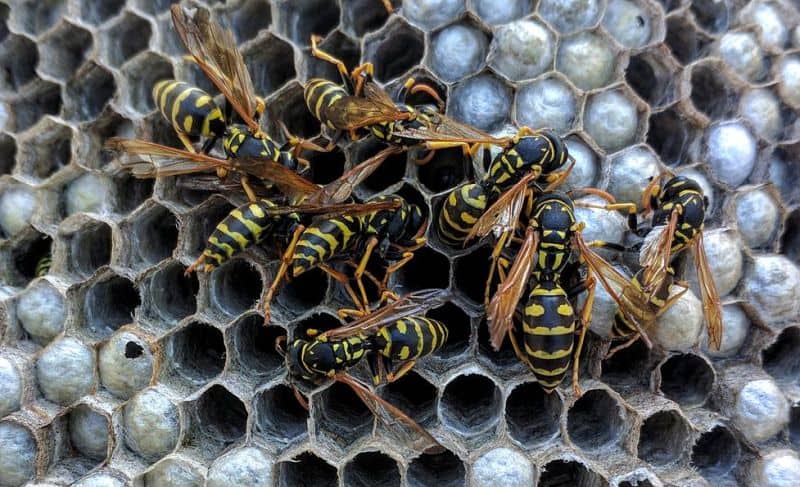
❌ Paper Wasps
These wasps use their saliva and plant material to create their nest – which have a paper-like appearance … hence their name. Paper wasps nests are shaped roughly like an umbrella, causing folks in some regions to refer to them as “umbrella wasps.”
Paper wasps build their nest in areas they feel are sturdy and offer protection, like window sills, doorways, inside of playhouses, barns, eaves, and sheds for example.
It is during the fall months that female paper wasps are most active. They often fly about looking for safe places ( the higher the better) to build a nest. These female insects will aggressively attack anyone that comes near their nest.
Around 24 different varieties of paper wasps are common throughout North America. They have narrow bodies in shades of brown, and black wings with yellow markings.
Paper wasps do pollinate garden plants, as well as feeding off of nectar, flies, beetle larvae, spiders, and caterpillars. But, because their bodies do not possess the hairiness of bees, their pollination activity is below average.
Paper wasps can become quite aggressive if someone gets near their nest, prompting a wave of stinging.
Because paper wasps offer some but only limited value and are prone to being aggressive, I would consider them a “bad bee.” The same tactics used to get rid of yellow jackets can be used to remove paper wasp nests.

❌ European Hornets
These are the big bad boys of the wasp world. I am going to go ahead and state that they are “bad bees” right up front. Hornets are not only aggressive if you get near their nest, they will chase you in large numbers far, far, far away – stinging painfully all the while.
Hornets have thick bodies and thin waistlines that are common to all varieties of wasps – but have thick and large bodies.
They are in the same insect subfamily as yellow jackets but are bigger than yellow jackets and a different color. Hornets have white, and black coloring and yellow jackets are only yellow and black.
Hornets are so large that their stinger is visible without a magnifier. They build paper thing nests high up in trees or on posts.
Rest assured it will not be one or a few hornets that happen to be outside of the hive and notice you that will attack (and let’s not forget chase) you but the entire inhabitants of the hive that happen to be home at the time will be summoned up for the stinging carnage.
Hornets are extremely dangerous – even if you do not have a bee allergy. Being stung repeatedly by these potent insects could seriously harm or even kill you.
If you manage to kill just one of the hornest before or during the attack, the pheromones released (all bees and bee-like insects have a powerful sense of smell) will alert all other hornest still in the hive or the near vicinity they need to assemble and attack, as well.
If the pheromones stick to your clothing, which can happen fairly easily, you will draw hornets outside of the immediate area around the hive as you are fleeing to safety – cross your fingers a vehicle or a pond is close by, that is about the only thing I have ever seen stop a hornet attack.
Hornets offer some small measure of pollination, but it’s surely not enough to willingly cohabitate with these violent stingers. I would much rather happen across a snake during a hike in the woods than a hornet’s nest.
One trail on our land is called, “Hornet Holler.” The hornets’ nests have all been burnt out now, but the first person through that trail was lucky enough to be on a 4-wheeler and could outrun the hornets… and still got stung in multiple places.
Call a professional, or at least someone experienced and who has a bee suit to remove hornets. This is not an easy or safe task, and should not be attempted by anyone untrained or unprepared.
Attracting Good Bees To Your Garden
Now that you know the difference between good bees and bad bees – and everything in between, it is time to learn how to attract beneficial pollinators.
In addition to the specific types of plants some bees are attracted to most already outlined in this guide, there are some general plants and herbs that you can grow to draw in all types of good pollinators – including butterflies.
Top 20 Plants That Attract Pollinators
| Rosemary | Beebalm |
| Clover – all types | Wild Geraniums |
| Mint – all types | Thyme |
| Echinacea | Chamomile – all types |
| Dandelion | Milkweed |
| Asters | Poppies |
| Zinnias | Daisies |
| Oregano | Sunflowers |
| Coriander | Goldenrod |
| Lavender | Wild Carrots – Queen Anne’s Lace |
Adding a shallow water feature to the garden is also highly recommended to attract pollinators. Bees do not want to fly very far between their food and water sources and their home.
Whether you are intentionally keeping bees or simply trying to court wild bees to visit your growing plots, add a bird bath, a shallow tray with water, or a similar type of water feature near the plants you want bees to pollinate.
Remember, however, that bees are not swimmers and drown themselves frequently when trying to water if the water source is not very shallow, or have small stones in it for the bees to balance upon.
Learning how to properly identify both good bees and bad bees – as well as both types of bee-like insects should be one the chief items of your gardening “to do” list.
Knowing what bees should be heralded and which ones are best removed from the homestead to avoid destruction and pain, is a very wise thing to do, indeed.
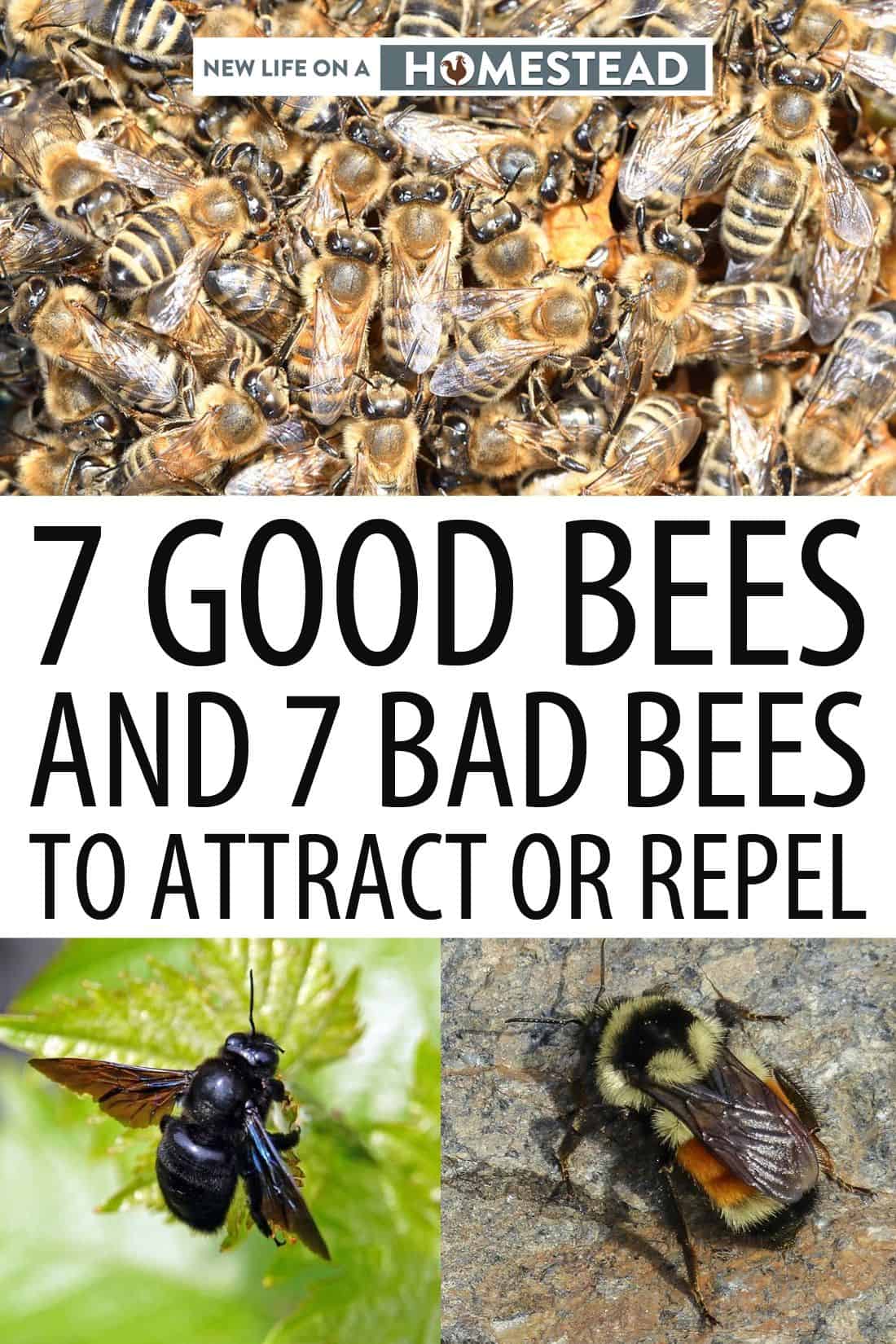
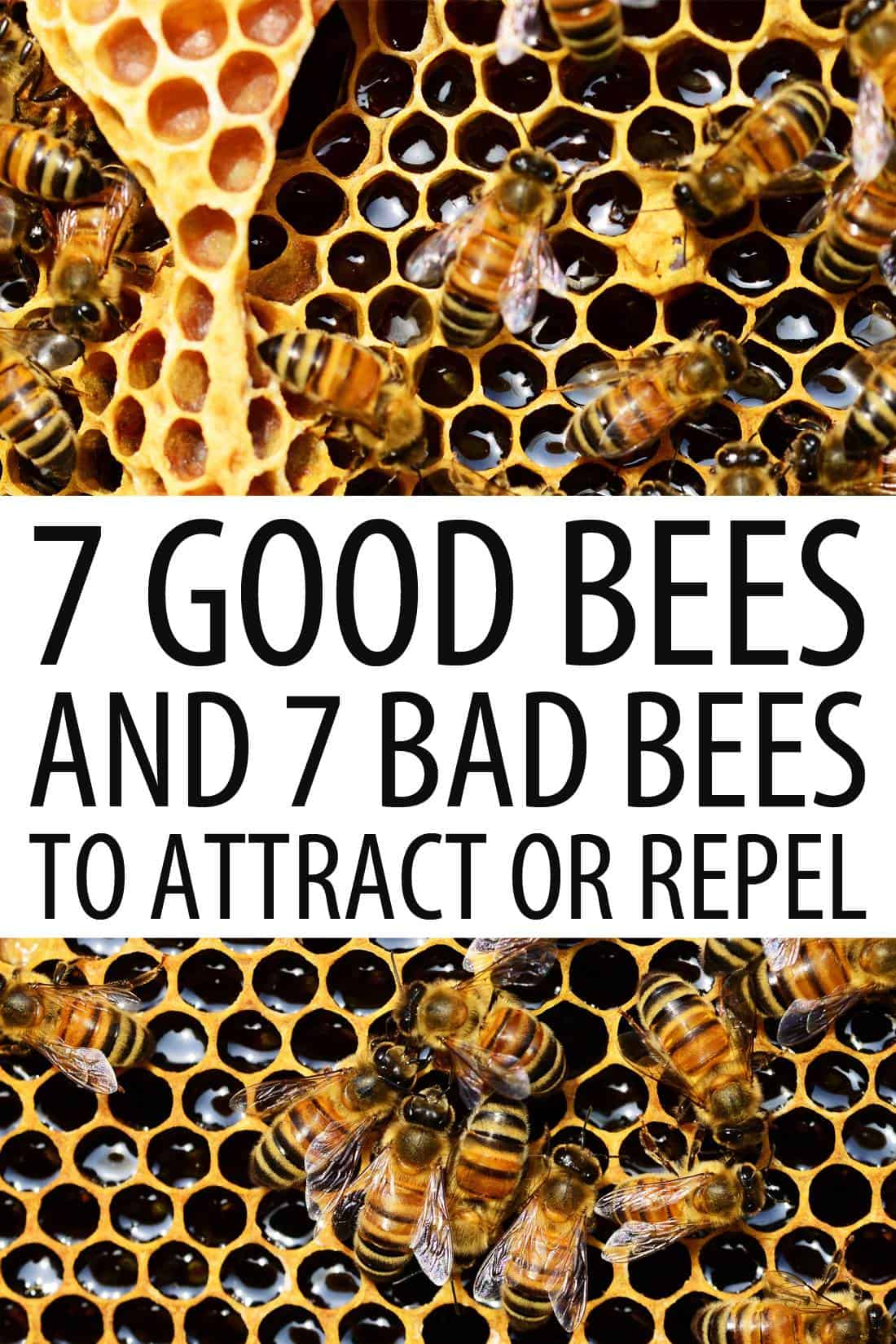

Tara lives on a 56 acres farm in the Appalachian Mountains, where she faces homesteading and farming challenges every single day, raising chickens, goats, horses, and tons of vegetables. She’s an expert in all sorts of homesteading skills such as hide tanning, doll making, tree tapping, and many more.

Thank you Tara for this excellent referral list of good and bad bees and for your clear writing.
I live in France and almost the entire country now has the presence of European hornets and, worse, Asian hornets. Most people see the European hornet as less of a threat than the Asian as they settled in long before the Asian hornets arrived and have assimilated to some degree. The Asian hornets are everyone’s “bad bee,” but especially beekeepers as the hornets kill their bees — as if the bees didn’t have enough problems already.
Best to you,
Jeanette Phillips